2025-01-27 graphs lecture 2
2025-01-27
See [[School/Archived/Equivariant Machine Learning/course_PDFs/Lecture 2.pdf]]
Housekeeping
- Scribing sign-up sheet, choose whichever lecture you want by Wednesday
- A few lectures cancelled
Last time
- [[graph]]s
- [[graph signals]]/data with graphs
- [[network diffusion process]]/ the way we can process data
- general definition of graph diffusion with graph shift operators
- the most common operators were the graph laplacian
Today
- interpretation of the [[graph laplacian]]
- [[total variation energy]] of graph signals
- [[graph frequencies]] and [[oscillation modes]]
- the graph fourier transform
- graph convolution (maybe)
1. [[Graph Signals and Graph Signal Processing]]
1.1 Interpretation of the (left)/directed [[graph laplacian]]
We begin with an example
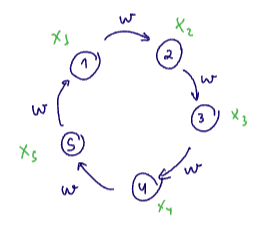
Consider a 5-cycle digraph with some signal
- For an
-cycle digraph, we can think of the graph as a periodic signal sampled at discrete time intervals
Recall the definition of the [[adjacency matrix]]:
the adjacency matrix for the 5-cycle digraph is $$A = \begin{bmatrix}
0 & 0 & 0 & 0 & w \
w & 0 & 0 & 0 & 0 \
0 & w & 0 & 0 & 0 \
0 & 0 & w & 0 & 0 \
0 & 0 & 0 & w & 0
\end{bmatrix}$$
The (left) laplacian is
Let
What does this definition of
This looks like the [[derivative]] of a function
The [[graph laplacian]] generalizes differentiation to arbitrary graphs.
1.2 Interpretation for the normalized symmetric laplacian
Similar to the [[graph laplacian]], we can build an interpretation for the normalized symmetric laplacian.
We will see that the (normalized) [[symmetric laplacian]] generalizes the idea of [[total variation energy]] for [[graph signals]].
The total variation energy of discrete-time signals is defined as
This is a good proxy for the signal frequency (and in fact can be used to estimate it)
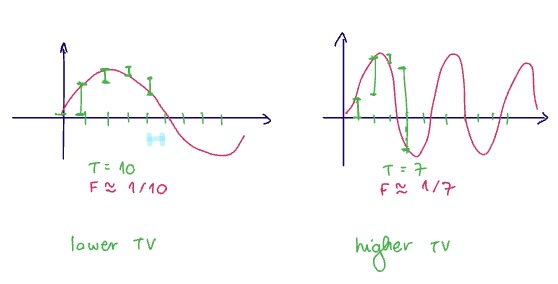
The example on the left with longer period has lower TV. The example on the right with shorter period has higher
High TV -> high frequency
Low TV -> low frequency
see also [[total variation distance]]
(see [[total variation energy]])
We first start with our interpretation of signals on digraphs as discrete time periodic data.
The laplacian kernel.
ie. Let
For a di-graph on
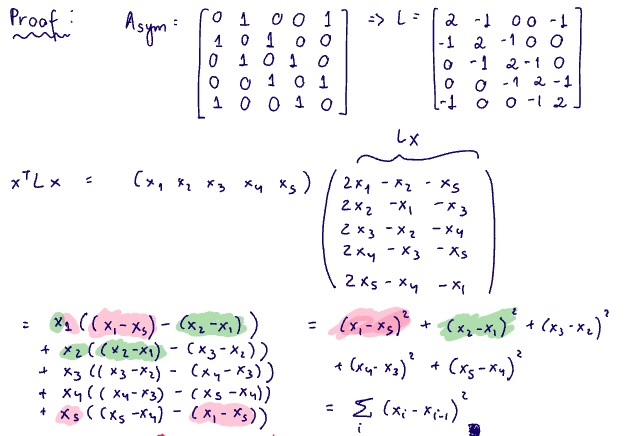
(see [[interpretation of the symmetric graph laplacian]])
General method for getting our interpretations:
- Recognizing that can represent time signals as cycle graphs ->
- Dy using the definitions of notions of differentiation and TVE/inner product, we can recover the classical definitions in this setting
- We then carry these interpretations to arbitrary graphs.
What if the signal frequency is higher than the number of nodes graph?
This is addressed in signal processing by the nyquist-shannon theorem. The gist is that we need the sampling period to be small enough to meaningfully capture the signal. And, for periodic signals, we can calculate this explicitly.
1.3 Building to the graph fourier transform 😀
Recall for (now arbitrary) signal on graph
What are the lowest and highest values
Let
- Note that
and is positive semidefinite and this is the minimum value for - The highest value
can take is
Show the symmetrized laplacian is positive semidefinite
The TVE gives us a range of values for the frequency of the signal of the graph.
- The eigenvalues are the graph's canonical frequencies
- the eigenvectors are the oscillation modes of those frequencies.
From now on, we will assume that the laplacian is the symmetrized version.
Now, let's consider the 4 digraph. Then
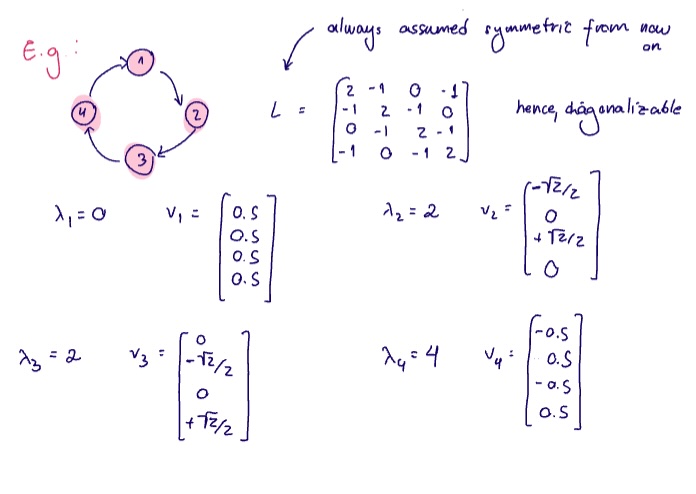
Since
For the example above,
--- start-multi-column
number of columns: 2
Shadow: off
Border: on
Column Spacing: 0
We can visualize these vectors as (discrete) time signals, where each of the nodes of the graphs correspond to the sampled locations.
What do we notice?
- As the eigenvalue increases, the frequency of the signal increases
has frequency
--- end-column ---
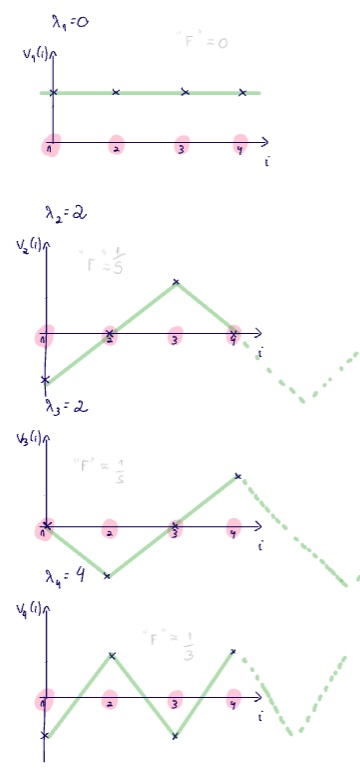
--- end-multi-column
An arbitrary graph is an algebraic extension of a cyclic graph. We can think of a general graph as a discrete sampling of some underlying data manifold.
Since
- ie, we can represent any graph signal
in this basis
More generally, this is true not just for the laplacian (which is symmetric and thus always diagonalizable), but for any diagonalizable graph shift operator
- adjacencies of undirected graph
- adjacencies of directed graphs, random walk matrix adjacencies and general [[graph laplacian]]s with distinct eigenvalues
(recall that a matrix is diagonalizable if it has all distinct eigenvalues)
Given a signal
and
(see [[graph fourier transform]])
Back to our 5 cycle example. Let's define a diagonalizable operator as follows:
- The eigenvalues are the complex exponentials
- The eigenvectors are given by the fourier basis, ie
is given by
The GFT here is then
And for general cyclical graphs on
nodes: And this is precisely the definition of the discrete Fourier transform(!!) ie, we can recover the classical definition for the (discrete) Fourier transform using our definition for the graph version.
The Fourier Transform in euclidian space into graph signal space.
-
In general, the interpretation of the adjacency eigenvalues as graph frequencies is not as clean as it is for the laplacian.
- The eigenvectors of
and do not generally match, and there is no alternative definition in terms of .
- The eigenvectors of
-
In practice, it is generally true that low-magnitude adjacency eigenvalues correspond to high graph frequencies and vice versa.
-
When considering the normalized adjacency matrix and the normalized laplacian, it is easy to see that the eigenvectors are the same.
- But in this case, the adjacency eigenvalues can NOT be interpreted as graph frequencies.